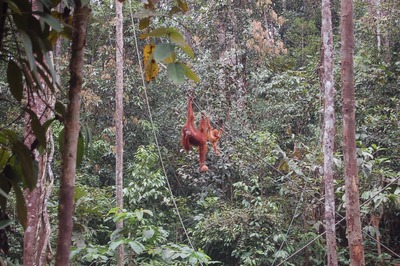Rescuing Bornean Orang Utans
The Semenggoh Wildlife Centre and the Matang Wildlife Centre in Sarawak help rehabilitate orang utans in distress. By Shona Lall Parekh.
Sarawak, 4th October 2015- Everyone stood in silence as the conservation officer repeatedly called into the forest. After about 10 minutes, our patience was rewarded when he nodded, indicating the presence of an orang utan in the vicinity. A delicious offering of local fruit awaited the magnificent creature.
 Rehabilitated orang utans at Semenggoh Wildlife Centre Shortly, a sharp-eyed boy pointed to the high trees of the rainforest. Murmured excitement spread and soon everyone eagerly strained to catch a glimpse of the deep orange coat amongst the green foliage. Broad smiles erupted as the giant primate gracefully swung its way towards the keeper, taking its time, as if knowing it was the centre of attraction.
Rehabilitated orang utans at Semenggoh Wildlife Centre Shortly, a sharp-eyed boy pointed to the high trees of the rainforest. Murmured excitement spread and soon everyone eagerly strained to catch a glimpse of the deep orange coat amongst the green foliage. Broad smiles erupted as the giant primate gracefully swung its way towards the keeper, taking its time, as if knowing it was the centre of attraction.
Sadammiah, a 13-year old orang utan appeared with her adorable baby, Ruby. The mother and her two-year old fed on fruit, mostly banana and a coconut. Sadammiah broke open the hard coconut effortlessly by hitting it against a tree trunk with several powerful strikes, while Ruby frolicked about her mother.
This precious glimpse into the world of semi-wild orang utans took place at the Semenggoh Wildlife Centre, a 30-year old centre that opened in 1975 for rehabilitating wild animals that are orphaned, hurt, or even incapacitated by long-term captivity “with the objective of subsequently releasing them back to the wild”.
The successful rehabilitation of orphaned orang utans propelled the centre to fame. Due to its overwhelming successes in orang utan rehabilitation – the forests have reached their maximum holding capacity - the centre now engages in the study of orang utans. In its place, the Matang Wildlife Centre focuses on rehabilitating injured or orphaned orang utans.
According to Kevin Nangai, Assistant Manager of Communications at Sarawak Tourism Board, "Semenggoh Wildlife Centre is sprawled over 700 acres where 27 thriving orang utans live in the wild under the watchful eyes of their keepers. Rehabilitation is also carried out at the newer Matang Wildlife Centre where orphaned orang utans are taught to survive in the wild."
Orang utans are specific to South East Asia. The word orang utan comes from the Malay/Indonesian word for ‘person’ – orang, and ‘forest’ – hutan, literally translating to “forest person”. Two known species, the Bornean orang utan and Sumatran orang utan, are both endangered; in fact, the Sumatran orang utan is listed as critically endangered. As of 2015, wild orang utan populations are estimated at 20,000 to 27,000 between Borneo (20,000) and Sumatra (7,000). Reasons for decline include habitat encroachment and destruction mostly through the raging annual fires caused by man, the cheapest method of clearing rainforest for agriculture primarily for palm cultivation. Other factors for decline – poaching and capture of these primates as illegal pets.
About Orang Utans
Highly solitary, orang utans rank amongst the most intelligent primates, and are arboreal by nature – making them the largest primates that live and nest in trees. Males and females vary in size and features: males are larger, weighing up to 100 kgs (220 lbs) and stand at 150 cm (5 feet) in height, while females are about half the size, weighing in the 50 kg range.
Mature adult males have cheek pads called flanges. Orang utans have a lifespan of approximately 45 years in the wild, fruit being the main source of diet. Durian, jackfruit, mango, lychee and other forest fare such as tree bark, shoots, egg, insects and sometimes even small lizards. Orang utans have single or twin babies, and stay with their mothers for the first seven to eight years of their lives, to the point where they have learnt to survive on their own. The slow replacement rate makes it even more difficult to reverse the decreasing wild orang utan populations.
Semenggoh Wildlife Centre is open from 8 a.m. to 12 p.m. and 2 p.m. to 4.45 p.m. However, the recommended time to see the orang utans is at feeding time. There are two daily feeding times:
Mornings - 9.00 a.m. to 10.00 a.m.
Afternoons - 3.00 p.m. to 4.00 p.m.
Do note that when the forests are abundant with fruit, orang utan encounters may decrease, and a visit to Matang Wildlife Centre may be more fruitful instead.
For enquiries and information on the frequency of orang utan sightings, contact National Parks Booking Office Tel: (+6) 082 248088, and visit www.sarawakforestry.com for more information on various programmes conducted by the centres.
Gaia Discovery thanks Sawarak Tourism Board for making this trip possible.
If you like this article, why not receive Gaia Discovery eNewsletters that bring you stories for free? Subscribe to Gaia Discovery here.